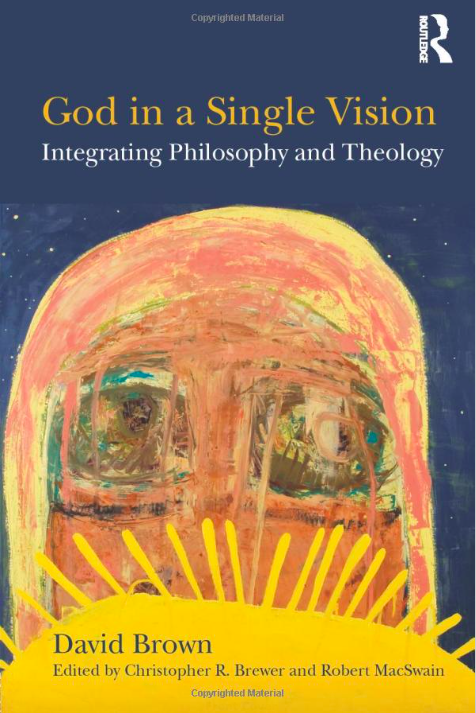David Brown is an analytic philosopher whose research has been described as following the Anglican via media (“a middle way”) tradition. He has made a career of placing himself between philosophy and systematic theology, and also as a moderate voice on the spectrum of each discipline (think: analytic/Continental, liberal/conservative, and Protestant/Catholic). In God in a Single Vision: Integrating Philosophy and Theology, Brown shares his contributions to philosophy and systematic theology through selected essays and lectures while attempting to address any gaps in his logic up to the volume’s publishing. Brown ultimately writes to convince philosophers and systematic theologians that their separate pursuits of truth would only benefit if placed in conversation. The philosopher would benefit from the systematic theologian’s use of metaphor, and the systematic theologian would equally benefit from the philosopher’s deliberate use of language as a means to theological clarity. Brown’s approach to building this claim involves discussing historically polarizing topics that have been misanalyzed due to lack of dialogue between philosophy and systematic theology, and proposing a synthesized way forward. Such topics include theodicy, revelation, the Trinity, atonement, and the communion of saints. Though Brown’s overarching emphasis on finding a balance between metaphor and deliberate language use begins to break down in “Part II: Experience and Revelation,” looking at “Part I: The Created Order,” especially his discussion on theodicy, gives a representative introduction to Brown’s general approach to select topics throughout his book.
To begin, Brown’s discussion of theodicy is found in “Part I: The Created Order.” Here, Brown explores God’s reason for creating, and follows with a study on alternatives to widely accepted doctrines of creation. The latter can be read as an exploration of “slippery” terms that cause more theological division than their meanings necessitate (such as pantheism and panentheism). Finally, after showing the reader that in tandem, philosophy and theology can comprehensively respond to the above creation queries, Brown addresses theodicy, concluding that “it is the philosopher’s task to deal with the general problem, the theologian’s with the specific case” (29). To theologians such as Karl Barth, Brown maintains that an explanation for theodicy cannot stop at the Cross, and to philosophers, he insists one cannot find a reason for senseless evil (and thus, theodicy). With the help of both disciplines, Brown presents a new way forward that builds on his creation discussion—that God values human freedom and so observes at a distance from the world, but also that “God continually extends the offer of a supporting divine presence to those faced with human tragedy and suffering” (43).
The reader will find that, like with theodicy, Brown hospitably explores each topic via media and also at the intersection of history, culture, and Scripture; however, his argument for metaphor in philosophy and deliberate language in systematic theology, while unequivocal within the topic of theodicy, lacks the same clarity throughout Parts II-IV. For example, throughout Part II, Brown bolsters his argument for religious experience as a locus of revelation, using both the logic of his argument and his evidence-based, historical approach to Scriptural exegesis. That said, readers might also note Brown’s disregard for his broader thesis, as Brown leaves it to the reader to make connections he seemingly promised to facilitate.
Brown begins Part II with the essay “Realism and Religious Experience,” addressing both negative and positive arguments for religious experience as a conduit of revealed theology with the help of John Hicks and Hilary Putnam (53, 54). Brown’s argument hinges on the clarification of key terms related to descriptions of religious experience such as “numinousness,” “transcendence,” and emotion, using historical analysis (48, 50). In doing so, Brown argues that multiple accounts of truth can be true, and so religious experience can be a source of theological truth not only in Christianity but across faith traditions (57). This conclusion strengthens his next essay on revelation—that Scripture is not the only locus of revelation because God reveals God’s self in accordance with human history through our cultural context.¹
In the following essay, “Present Revelation and Past ‘Problematic’ Texts,” Brown builds on this logic of religious experience as valid revelation while again criticizing theologians for pointing too easily to the Cross, or skipping problematic texts in the lectionary entirely, rather than considering a gradual sharing of divine truth over the timeline of Scripture, both within its chronological narrative from Old to New Testaments and also through cultural changes in the wider world (62). Brown mentions Jesus’ preference for male disciples—and so, Jesus the Christ was also a perpetuator of the patriarchal culture around him. When culture is a locus of revelation alongside Scripture, the two loci encourage a “divine dialogue” where God waits “on an adequate human response that fully respects human freedom” (62).² Therefore, an omnipotent deity (the God-man) was not limited by human sin, but rather walked alongside humanity at our cultural pace.
The last essay of Part II, “From Past Meaning to Present Revelation: Evaluating Three Approaches,” is where Brown explores three forms of exegesis (theological, philosophical, and biblical) that have been historically used by the Church, and their shortcomings, through their historical approaches to Scripture. Brown’s engagement with the history of the philosophical reading of Scripture is most compelling as he critiques both Richard Swinburne and Eleanore Stump for attempting “to read every text as directly expressive of the mind of God, even if it also bears other meanings” (78). Brown proposes instead a principle of prayerful reception “in which the text is respected but allowed to carry believers further, as the rest of their understanding of God and His purposes are brought to bear on its final import”—a proposal that logically coincides with his doctrine of revelation (81). Brown then moves on to the work of biblical scholars, ultimately commending Diana Lipton (a Jewish scholar) and Paul M. Joyce (a Christian scholar) for their work in reception exegesis “‘because it signals that the enterprise [of responsible exegesis] involves not merely cataloguing cases of reception but also critical analysis’” (82). Brown closes Part II with a call to both philosophers and theologians to take seriously the contributions biblical scholars make to this “enterprise” (83).
While Brown’s argument for the use of more metaphor in philosophy and deliberate language in theology can be inferred throughout Part II, Brown fails to explicitly restate this. This weakness is seen particularly during the development of his argument for the two loci of revelation and could act as a barrier to understanding for the reader. As someone who has a Master of Divinity, I was able to infer the continued push for the integration of philosophy and theology which becomes abundantly clear as Part II concludes and Brown argues for human experience, including philosophy, as a locus of revelation alongside that of Scripture (83). However, while his subject matter proves important to my view of Scripture, a pastoral professional with less experience in philosophy and theology might find Brown’s highly detailed writing difficult to connect back to the overarching thesis of his entire work. This weakness only grows in “Part III: Incarnation, Trinity, and Redemption” and “Part IV: Heaven and our Communal Destiny.”
Nevertheless, reading God in a Single Vision was more rewarding than it was difficult. Brown’s argument for a locus of revelation within present-day culture proves refreshingly moderate as he takes seriously the roles of theology, philosophy, and biblical scholarship in best representing topics such as theodicy that, as a progressive Christian, I would otherwise abandon as unsolvable or as a matter for the Cross. In Parts III and IV, the reader will find similarly hospitable, via media interventions into the similarly contentious (and sometimes just mean-spirited) debates on the Trinity, atonement, and the communion of saints. This book is not meant for lay people without higher philosophical or theological education, but it opens doors for dialogue between poles of different intellectual traditions that should be engaged with and taught for the sake of the wider Church.
1. When Brown references ‘cultural context,’ he is pointing to the use of philosophy (or even natural theology) as a source of revelation, since philosophy is by definition the making sense of the human experience. It is through this philosophical locus of revelation that we are able to better understand what God has to say about 21st century issues like the climate crisis, feminism, and equity.
2. Note that Brown’s logical framework for the cases of theodicy and revelation both rely heavily on human freedom.




